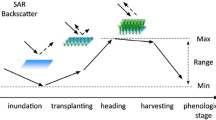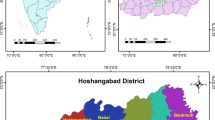Abstract
It is of paramount importance to have sustainable agriculture since agriculture is the backbone of many nations’ economic development. Majority of agricultural professionals rarely capture the cropping patterns necessary to promote Good Agricultural Practises. Objective of this research is to explore the potential of mapping cropping patterns occurring on different field parcels on small-scale farmlands in Zimbabwe. The first study location under investigation are the International Maize and Wheat Improvement Center (CIMMYT) research station and a few neighboring fields, the second is Middle Sabi Estate. Fourier time series modeling was implemented to determine the trends befalling on the two study sites. Results reveal that Sentinel-1 synthetic aperture radar (SAR) time series allow detection of subtle changes that occur to the crops and fields respectively, hence can be utilized to detect cropping patterns on small-scale farmlands. Discrimination of the main crops (maize and soybean) grown at CIMMYT was possible, and crop rotation was synthesized where sowing starts in November. A single cropping of early and late crops was observed, there were no winter crops planted during the investigation period. At Middle Sabi Estate, single cropping on perennial sugarcane fields and triple cropping of fields growing leafy vegetables, tomatoes and onions were observed. Classification of stacked images was used to derive the crop rotation maps representing what is practised at the farming lands. Random forest classification of the multi-temporal image stacks achieved overall accuracies of 99% and 95% on the respective study sites. In conclusion, Sentinel-1 time series can be implemented effectively to map the cropping patterns and crop rotations occurring on small-scale farming land. We recommend the use of Sentinel-1 SAR multi-temporal data to spatially explicitly map cropping patterns of single-, double- and triple-cropping systems on both small-scale and large-scale farming areas to ensure food security.
Similar content being viewed by others
References
Ban Y, Howarth P J, 1999. Multitemporal ERS-1 SAR data for crop classification: a sequential-masking approach. Canadian Journal of Remote Sensing, 25(5): 438–147. doi: https://doi.org/10.1080/07038992.1999.10874743
Bargiel D, 2017. A new method for crop classification combining time series of radar images and crop phenology information. Remote Sensing of Environment, 198: 369–383. doi: https://doi.org/10.1016/j.rse.2017.06.022
Bégué A, Arvor D, Bellon B et al., 2018. Remote sensing and cropping practices: a review. Remote Sensing, 10(1): 99. doi: https://doi.org/10.3390/rs10010099
Bharati P, De U K, Pal M, 2015. A modified diversity index and its application to crop diversity in Assam, India. AIP Conference Proceedings, 1643(1): 19–29. doi: https://doi.org/10.1063/1.4907421
Breiman L, 2001. Random forest. Machine Learning, 45(1): 5–32. doi: https://doi.org/10.1109/ACCESS.2019.2912807.
Chamundeeswari V V, Singh D, Singh K, 2007. Unsupervised land cover classification of SAR images by contour tracing. In: Proceedings of 2007 IEEE International Geoscience and Remote Sensing Symposium. Barcelona, Spain: IEEE, 547–550. doi: https://doi.org/10.1109/IGARSS.2007.4422852
CIMMYT, 2016. Our work. https://doi.org/www.cimmyt.org/our-work/. Cited 22 March 2018.
Crawford M M, Ricard M R, 1998. Hierarchical classification of SAR data using a markov random field model. In: Proceedings of 1998 IEEE Southwest Symposium on Image Analysis and Interpretation. Tucson, AZ, USA: IEEE. doi: https://doi.org/10.1109/IAI.1998.666864
de Oliveira A T C, de Oliveira L T, de Carvalho L M T et al., 2009. Separabilities of forest types in amplitude-phase space of multi-temporal MODIS NDVI. In: Proceedings of the Anais 14th Simpósio Brasileiro de Sensoriamento Remoto. Natal, Brasil: INPE, 7.
Dimov D, Kuhn J, Conrad C, 2016. Assessment of cropping system diversity in the fergana valley through image fusion of landsat 8 and sentinel-1. Proceedings of ISPRS Annals of the Photogrammetry, Remote Sensing and Spatial Information Sciences. Prague, Czech Republic: ISPRS, 173–180. doi: https://doi.org/10.5194/isprsannals-III-7-173-2016
Doukkali F, 2017. Clustering using K-means algorithm. Towards Data Science. https://doi.org/towardsdatascience.com/clustering-using-k-means-algorithm-81da00f156f6?gi=c1eec7743ec0. Cited 20 March 2018
Dzirutwe M, 2015. Zimbabwe takes tobacco road to agriculture recovery. https://doi.org/www.yahoo.com/news/zimbabwe-takes-tobacco-road-agriculture-recovery-082633369-business.html. Cited 21 March 2018
Foody G M, McCulloch M B, Yates W B, 1994. Crop classification from c-band polarimetric radar data. International Journal of Remote Sensing, 15(14): 2871–2885. doi: https://doi.org/10.1080/01431169408954289
Forkuor G, Conrad C, Thiel M et al., 2014. Integration of optical and synthetic aperture radar imagery for improving crop mapping in Northwestern Benin, West Africa. Remote Sensing, 6(7): 6472–6499. doi: https://doi.org/10.3390/rs6076472
Heller E, Rhemtulla J, Lele S et al., 2012. Mapping crop types, irrigated areas, and cropping intensities in heterogeneous landscapes of southern india using multi-temporal medium-resolution imagery: implications for assessing water use in agriculture. Photogrammetric Engineering & Remote Sensing, 78(8): 815–827. doi: https://doi.org/10.14358/PERS.78.8.815
Hütt C, Waldhoff G, 2018. Multi-data approach for crop classification using multitemporal, dual-polarimetric TerraSAR-X data, and official geodata. European Journal of Remote Sensing, 51(1): 62–74. doi: https://doi.org/10.1080/22797254.2017.1401909
Jackson R D, 1984. Remote sensing of vegetation characteristics for farm management. In: Proceedings of SPIE 0475, Remote Sensing: Critical Review of Technology. Arlington: SPIE. doi: https://doi.org/10.1117/12.966243
Lee J S, Jurkevich I, Dewaele P et al. 1994, Speckle filtering of synthetic aperture aadar images: a review. Remote Sensing Reviews, 8(4): 313–40. https://doi.org/10.1080/02757259409532206
Le Toan T, Laur H, Mougin E et al., 1989. Multitemporal and dual-polarization observations of agricultural vegetation covers by X-band SAR images. IEEE Transactions on Geoscience and Remote Sensing, 27(6): 709–718. doi: https://doi.org/10.1109/TGRS.1989.1398243
Lin Sen, Liu Ronggao, 2016. A simple method to extract tropical monsoon forests using NDVI based on MODIS data: a case study in South Asia and Peninsula Southeast Asia. Chinese Geographical Science, 26(1): 22–34. doi: https://doi.org/10.1007/s11769-015-0789-3
Lopes A, Nezry E, Touzi R et al., 1993. Structure detection and statistical adaptive speckle filtering in SAR images. International Journal of Remote Sensing, 14(9): 1735–1758. doi: https://doi.org/10.1080/01431169308953999
Marongwe L, Kwazira M, Jenrich et al., 2011. An African success: the case of conservation agriculture in Zimbabwe. International Journal of Agricultural Sustainability, 9(1): 153–161. doi: https://doi.org/10.3763/ijas.2010.0556
Martínez-Casasnovas J A, Martín-Montero A, 2003. Application of Landsat TM images to map long term cropping patterns. https://doi.org/www.macaulay.ac.uk/workshop/remotesensing2004/JAMC_Full_paper.pdf. Cited 24 March 2018
Mattia F, Satalino G, Balenzano A et al., 2015. Sentinel-1 for wheat mapping and soil moisture retrieval. Proceedings of 2015 IEEE International Geoscience and Remote Sensing Symposium. Milan, Italy: IEEE, 2832–2835. doi: https://doi.org/10.1109/IGARSS.2015.7326404
McNairn H, Shang J L, 2016. A review of multitemporal synthetic aperture radar (SAR) for crop monitoring. In: Ban Y F (ed). Multitemporal Remote Sensing: Methods and Applications. Cham: Springer, 317–340. doi: https://doi.org/10.1007/978-3-319-47037-5_15
Moran S M, Alonso L, Moreno J F et al., 2012. A RADARSAT-2 quad-polarized time series for monitoring crop and soil conditions in Barrax, Spain. IEEE Transactions on Geoscience and Remote Sensing, 50(4): 1057–1070. doi: https://doi.org/10.1109/TGRS.2011.2166080
Mukwada G, Manatsa D, 2013. Geospatial and temporal analysis of drought years in Zimbabwe, 1940–1999. Geographia Polonica, 86(4): 313–326. doi: https://doi.org/10.7163/GPol.2013.26
Nagraj G M, Karegowda A G, 2016. Crop mapping using SAR imagery: an review. International Journal of Advanced Research in Computer Science, 7(7): 47–52.
Nguyen D B, Clauss K, Cao S M et al., 2015. Mapping rice seasonality in the mekong delta with multi-year envisat ASAR WSM data. Remote Sensing, 7(12): 15868–15893. doi: https://doi.org/10.3390/rs71215808.
Nyoungui E, Tonye E, Akono A, 2002. Evaluation of Speckle Filtering and Texture Analysis Methods for Land Cover Classification from SAR Images. International Journal of Remote Sensing, 23(9): 1895–1925. doi: https://doi.org/10.1080/01431160110036157
Ozdarici A, Akyurek A, 2010. A Comparison of SAR Filtering Techniques on Agricultural Area Identification. In: ASPRS 2010 Annual Conference. San Diego, USA. https://doi.org/info.asprs.org/publications/proceedings/sandiego2010/sandiego10/Ozdarici.pdf. Cited 17 May 2019
Portnoi M D, 2017. Methods for Sugarcane Harvest Detection Using Polarimetric SAR. Stellenbosch: Stellenbosch University.
Satalino G, Mattia F, Le Toan T et al., 2009. Wheat crop mapping by using ASAR AP data. IEEE Transactions on Geoscience and Remote Sensing, 47(2): 527–530. doi: https://doi.org/10.1109/TGRS.2008.2008026
Sharma M P, Yadav M, Prawasi R et al., 2011. Cropping system analysis using remote sensing and GIS: a block level study of kurukshetra district. ARPN Journal of Agricultural and Biological Science, 6(10): 45–51.
Suresh G, Gehrke R, Wiatr T et al., 2016. Synthetic aperture radar (SAR) based classifiers for land applications in germany. Proceedings of International Archives of the Photogrammetry, Remote Sensing and Spatial Information Sciences. Prague, Czech Republic: ISPRS, 1187–1193. doi: https://doi.org/10.5194/isprs-archives-XLI-B1-1187-2016
Toringepi G, 2016. The Contribution of Smallholder Agriculture Production to Food Security in Rural Zimbabwe: A Case Study of Masvingo Province. South Africa: University of Fort Hare
Veci L, 2016. Sentinel-1 toolbox: TOPS interferometry tutorial. https://doi.org/step.esa.int/docs/tutorials/S1TBX%20TOPSAR%20Interferometry%20with%20Sentinel-1%20Tutorial.pdf. Cited 20 March 2018
Wang Dan, Lin Hui, Chen Jinsong et al., 2010. Application of multi-temporal ENVISAT ASAR data to agricultural area mapping in the pearl river delta. International Journal of Remote Sensing, 31(6): 1555–1572. doi: https://doi.org/10.1080/01431160903475258
Wegmüller U, Werner A, Wiesmann A et al., 2016. Time-series analysis of sentinel-1 interferometric wide swath data: techniques and challenges. Proceedings of 2016 IEEE International Geoscience and Remote Sensing Symposium. Beijing, China: IEEE, 3898–3901. doi: https://doi.org/10.1109/IGARSS.2016.7730012
Yan Huimin, Xiao Xiangming, Huang Heqing et al., 2014. Multiple cropping intensity in China derived from agro-meteorological observations and MODIS data. Chinese Geographical Science, 24(2): 205–219. doi: https://doi.org/10.1007/s11769-013-0637-2
Acknowledgement
We are grateful to Dr. Mainassara Zaman-Allah, Richard Makanza and Savemore Ngirazi for providing unmanned aerial vehicle (UAV) images.
Author information
Authors and Affiliations
Corresponding authors
Additional information
Foundation item: Under the auspices of Fundamental Research Funds for the Central Universities, China (No. 2017TD-26), the Plan for Changbai Mountain Scholars of Jilin Province, China (No. JJLZ[2015]54)
Rights and permissions
About this article
Cite this article
Useya, J., Chen, S. Exploring the Potential of Mapping Cropping Patterns on Smallholder Scale Croplands Using Sentinel-1 SAR Data. Chin. Geogr. Sci. 29, 626–639 (2019). https://doi.org/10.1007/s11769-019-1060-0
Received:
Accepted:
Published:
Issue Date:
DOI: https://doi.org/10.1007/s11769-019-1060-0




